ESP BMW X5 4.8IS 2006 E53 User Guide
[x] Cancel search | Manufacturer: BMW, Model Year: 2006, Model line: X5 4.8IS, Model: BMW X5 4.8IS 2006 E53Pages: 202, PDF Size: 4.13 MB
Page 56 of 202
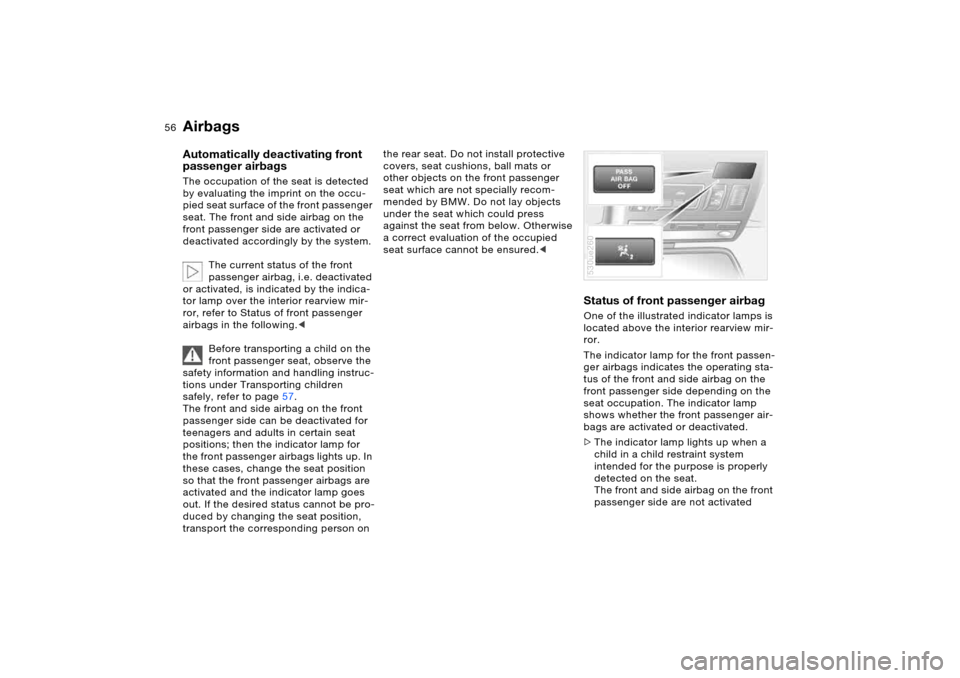
56n
AirbagsAutomatically deactivating front
passenger airbagsThe occupation of the seat is detected
by evaluating the imprint on the occu-
pied seat surface of the front passenger
seat. The front and side airbag on the
front passenger side are activated or
deactivated accordingly by the system.
The current status of the front
passenger airbag, i.e. deactivated
or activated, is indicated by the indica-
tor lamp over the interior rearview mir-
ror, refer to Status of front passenger
airbags in the following.<
Before transporting a child on the
front passenger seat, observe the
safety information and handling instruc-
tions under Transporting children
safely, refer to page57.
The front and side airbag on the front
passenger side can be deactivated for
teenagers and adults in certain seat
positions; then the indicator lamp for
the front passenger airbags lights up. In
these cases, change the seat position
so that the front passenger airbags are
activated and the indicator lamp goes
out. If the desired status cannot be pro-
duced by changing the seat position,
transport the corresponding person on
the rear seat. Do not install protective
covers, seat cushions, ball mats or
other objects on the front passenger
seat which are not specially recom-
mended by BMW. Do not lay objects
under the seat which could press
against the seat from below. Otherwise
a correct evaluation of the occupied
seat surface cannot be ensured.<
Status of front passenger airbagOne of the illustrated indicator lamps is
located above the interior rearview mir-
ror.
The indicator lamp for the front passen-
ger airbags indicates the operating sta-
tus of the front and side airbag on the
front passenger side depending on the
seat occupation. The indicator lamp
shows whether the front passenger air-
bags are activated or deactivated.
>The indicator lamp lights up when a
child in a child restraint system
intended for the purpose is properly
detected on the seat.
The front and side airbag on the front
passenger side are not activated530ue260
Page 57 of 202

57n
OverviewControlsMaintenanceRepairsDataIndex
Airbags Transporting children safely >The indicator lamp does not light up
when, for example, a correctly seated
person of sufficient height is detected
on the seat. The front and side airbag
on the front passenger side are acti-
vated
>The indicator lamp does not light up
when the seat is empty.
The front and side airbag on the front
passenger side are not activated.Operational readiness of airbag
system
As of ignition key position 1, the
warning lamp in the instrument
cluster lights up for a short time,
thus indicating the operational readi-
ness of the entire airbag system and the
safety belt tensioners.
Airbag system malfunction:
>Warning lamp does not light up as of
ignition key position 1
>Warning lamp lights up continuously.
Have the airbag system checked
immediately if a malfunction
occurs, as otherwise there is a danger
of the system failing to respond in the
expected manner in an accident of cor-
responding severity.<
The right place for children
Do not leave children unattended
in the vehicle, as otherwise they
could endanger themselves and other
persons, e.g. by opening the doors.<
In principle, all seats in your BMW
except the driver's seat are suitable for
mounting universal child restraint sys-
tems for all ages which are approved
for the respective age group.
Children always in the rear:
Accident research shows that the saf-
est place for children is on the back
seat.
Only transport children under
13 years of age or less than 5 ft/
150 cm tall in the rear in child restraint
systems intended for the respective
age, weight and height of the child.
Otherwise there is an increased danger
of injury in an accident.<
Children 13 years of age or older must
wear a safety belt as soon as a suitable
child restraint system can no longer be
used due to their age, size and weight.
All rear seat positions in your vehicle
comply with the recommendations of
the standard SAE J1819 for the safe
securing of child restraint systems in
motor vehicles.
Exception for front passenger seat:
Should it be necessary to use a
child-restraint system on the front
passenger seat, the front and side air-
bags must be deactivated. Otherwise,
there is an increased risk of injury for
the child when the airbags are trig-
gered, even with a child-restraint sys-
tem. Your BMW Sports Activity Vehicle
center will be happy to advise you.<
More information on automatic deacti-
vation of the front passenger airbags,
refer to page56.
Page 78 of 202

78n
Check Control >CHECK BRAKE FLUID
Level has dropped approx. to mini-
mum. Have the brake fluid replen-
ished as soon as possible, refer to
page155. Have the reason for the
brake fluid loss eliminated by your
BMW Sports Activity Vehicle center
>DSC/4x4 INACTIVE
DSC and/or four-wheel drive system
xDrive has failed.
The stabilizing interventions of DSC
and/or the four-wheel drive system
xDrive are no longer available. Drive
may be being exerted exclusively via
the rear axle.
Have the system checked at the
nearest BMW Sports Activity Vehicle
center.
For additional information, refer to
page94
>SELFLEVEL SUSP.INACT
*
Please consult the nearest BMW
Sports Activity Vehicle center
>SELFLEVEL SUSP.INACT*
MAX. 35 MPH/MAX. 60 KM/H
*
These messages are displayed con-
secutively.
Do not exceed a maximum speed of
35 mph/60 km/h.
Please consult the nearest BMW
Sports Activity Vehicle center>TRANSMISS'N OVERHEAT
*
Reduce speed immediately and stop
at a suitable location so that the sys-
tem can cool down again. Please
contact the nearest BMW Sports
Activity Vehicle center.
>LIMIT
*
Display when the programmed road-
speed limit is exceeded, refer to
page85.
Priority 2
These displays appear for 20 seconds
as of ignition key position 2. The warn-
ing symbols remain after the message
disappears. You can open the mes-
sages again for display by pressing the
CHECK button.
>TRUNKLID OPEN
This message only appears when
starting off
>DOOR OPEN
This message appears after a minimal
defined road speed has been
exceeded
>FASTEN SEAT BELTS
*
In addition, the indicator lamp with
the belt symbol lights up and an
acoustic signal sounds
>WASHER FLUID LOW
Too low, top up at the next opportu-
nity, refer to page152>CHECK ENGINE OIL LEV
The oil level is at the absolute mini-
mum point. Therefore, have the
engine oil replenished as soon as
possible, refer to page152. Until
then, do not drive more than approx.
30 miles/50 km.
>CHECK GAS CAP
Check to see whether the fuel filler
cap has been closed properly, refer
to page25
>OUTSIDE TEMP. +237/–56
This display is only an example. The
current temperature is displayed at
outside temperatures of +37.57/
+36 and below, refer also to
page73
>CHECK BRAKE LIGHTS
A lamp has failed or the electrical
circuit has a malfunction, refer to
page163 or consult a BMW Sports
Activity Vehicle center
>CHECK LOWBEAM LIGHTS
CHECK SIDE LIGHTS
CHECK REAR LIGHTS
CHECK FRONT FOGLAMPS
CHECK LICPLATE LIGHT
CHECK HIGHBEAM LIGHT
CHECK BACK UP LIGHTS
The respective lamp may have failed
or the electrical circuit may be defec-
tive, refer to page161 or consult a
BMW Sports Activity Vehicle center
Page 91 of 202
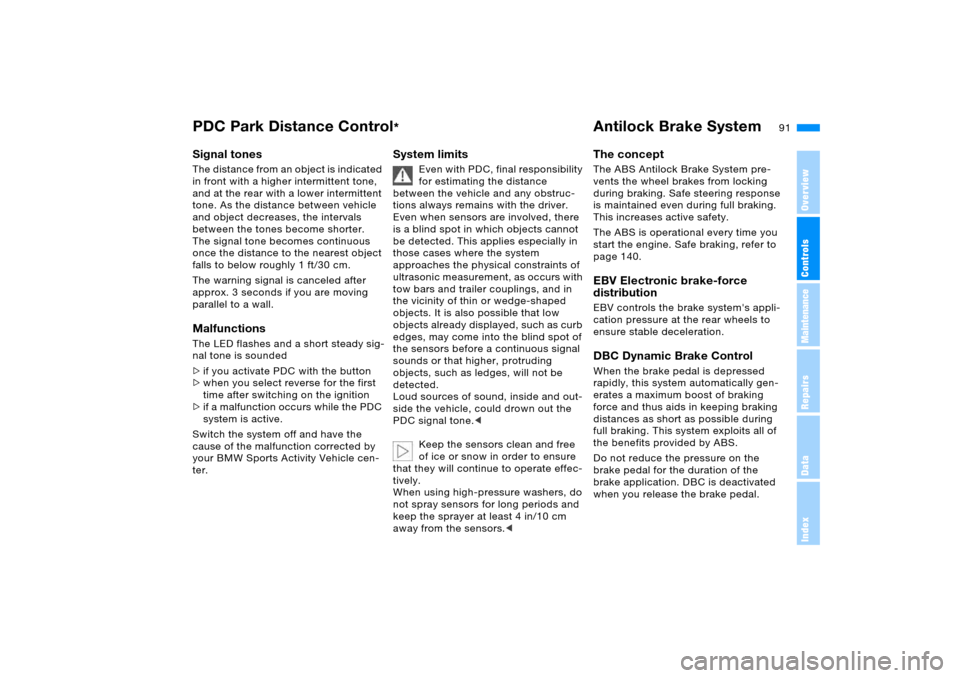
91n
OverviewControlsMaintenanceRepairsDataIndex
PDC Park Distance Control
* Antilock Brake System
Signal tones The distance from an object is indicated
in front with a higher intermittent tone,
and at the rear with a lower intermittent
tone. As the distance between vehicle
and object decreases, the intervals
between the tones become shorter.
The signal tone becomes continuous
once the distance to the nearest object
falls to below roughly 1 ft/30 cm.
The warning signal is canceled after
approx. 3 seconds if you are moving
parallel to a wall. MalfunctionsThe LED flashes and a short steady sig-
nal tone is sounded
>if you activate PDC with the button
>when you select reverse for the first
time after switching on the ignition
>if a malfunction occurs while the PDC
system is active.
Switch the system off and have the
cause of the malfunction corrected by
your BMW Sports Activity Vehicle cen-
ter.
System limits
Even with PDC, final responsibility
for estimating the distance
between the vehicle and any obstruc-
tions always remains with the driver.
Even when sensors are involved, there
is a blind spot in which objects cannot
be detected. This applies especially in
those cases where the system
approaches the physical constraints of
ultrasonic measurement, as occurs with
tow bars and trailer couplings, and in
the vicinity of thin or wedge-shaped
objects. It is also possible that low
objects already displayed, such as curb
edges, may come into the blind spot of
the sensors before a continuous signal
sounds or that higher, protruding
objects, such as ledges, will not be
detected.
Loud sources of sound, inside and out-
side the vehicle, could drown out the
PDC signal tone.<
Keep the sensors clean and free
of ice or snow in order to ensure
that they will continue to operate effec-
tively.
When using high-pressure washers, do
not spray sensors for long periods and
keep the sprayer at least 4 in/10 cm
away from the sensors.<
The concept The ABS Antilock Brake System pre-
vents the wheel brakes from locking
during braking. Safe steering response
is maintained even during full braking.
This increases active safety.
The ABS is operational every time you
start the engine. Safe braking, refer to
page 140.EBV Electronic brake-force
distribution EBV controls the brake system's appli-
cation pressure at the rear wheels to
ensure stable deceleration.DBC Dynamic Brake Control When the brake pedal is depressed
rapidly, this system automatically gen-
erates a maximum boost of braking
force and thus aids in keeping braking
distances as short as possible during
full braking. This system exploits all of
the benefits provided by ABS.
Do not reduce the pressure on the
brake pedal for the duration of the
brake application. DBC is deactivated
when you release the brake pedal.
Page 92 of 202

92n
Antilock Brake System DSC Dynamic Stability Control MalfunctionsPlease be absolutely sure to follow
instructions regarding possible combi-
nations of indicator lights on page 20.
The concept DSC prevents the drive wheels from
slipping when starting off and acceler-
ating. DSC also identifies unstable driv-
ing conditions, such as a loss of trac-
tion at the rear of the vehicle or sliding
of the vehicle in its front wheels. Under
these circumstances, DSC helps the
vehicle maintain a safe course within
the physical limits by reducing the
engine output and by applying the
brakes in the individual wheels.
The DSC is operational every time you
start the engine.
The laws of physics cannot be
repealed, even with DSC. An
appropriate driving style always
remains the responsibility of the driver.
So please do not further limit the addi-
tional safety margin by taking unneces-
sary risks.<
Indicator lamp
The indicator lamp in the instru-
ment cluster goes out shortly
after the engine is started.
The indicator lamp flashes:
DSC is active and is regulating drive
and braking force.
The indicator lamp stays lit:
DSC has been switched off using the
button and the stabilizing interventions
are no longer available.
Page 95 of 202
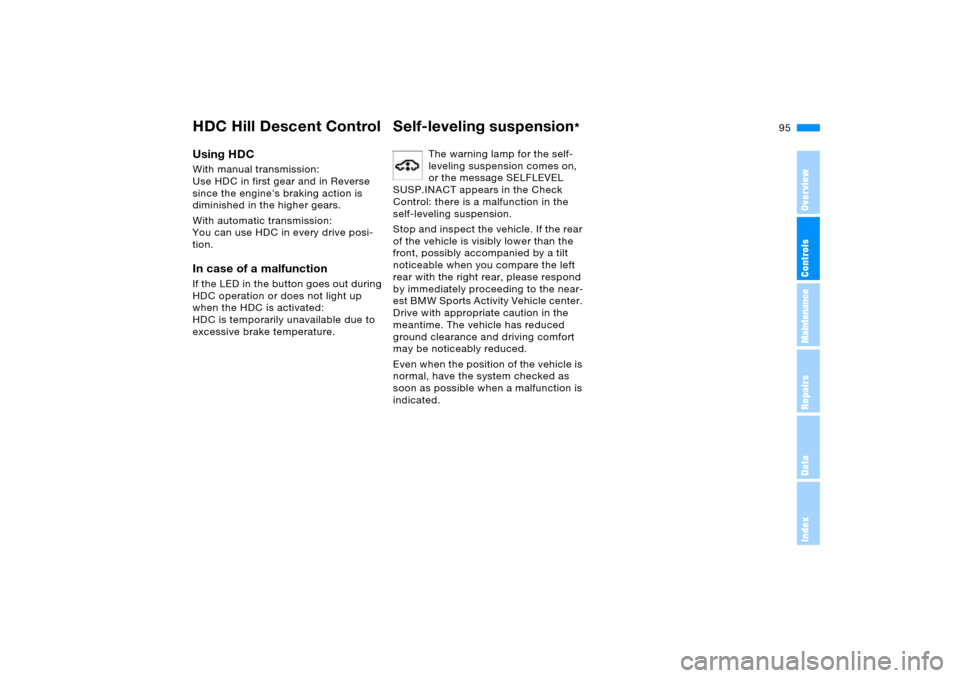
95n
OverviewControlsMaintenanceRepairsDataIndex
HDC Hill Descent Control Self-leveling suspension
*
Using HDC With manual transmission:
Use HDC in first gear and in Reverse
since the engine's braking action is
diminished in the higher gears.
With automatic transmission:
You can use HDC in every drive posi-
tion. In case of a malfunction If the LED in the button goes out during
HDC operation or does not light up
when the HDC is activated:
HDC is temporarily unavailable due to
excessive brake temperature. The warning lamp for the self-
leveling suspension comes on,
or the message SELFLEVEL
SUSP.INACT appears in the Check
Control: there is a malfunction in the
self-leveling suspension.
Stop and inspect the vehicle. If the rear
of the vehicle is visibly lower than the
front, possibly accompanied by a tilt
noticeable when you compare the left
rear with the right rear, please respond
by immediately proceeding to the near-
est BMW Sports Activity Vehicle center.
Drive with appropriate caution in the
meantime. The vehicle has reduced
ground clearance and driving comfort
may be noticeably reduced.
Even when the position of the vehicle is
normal, have the system checked as
soon as possible when a malfunction is
indicated.
Page 96 of 202
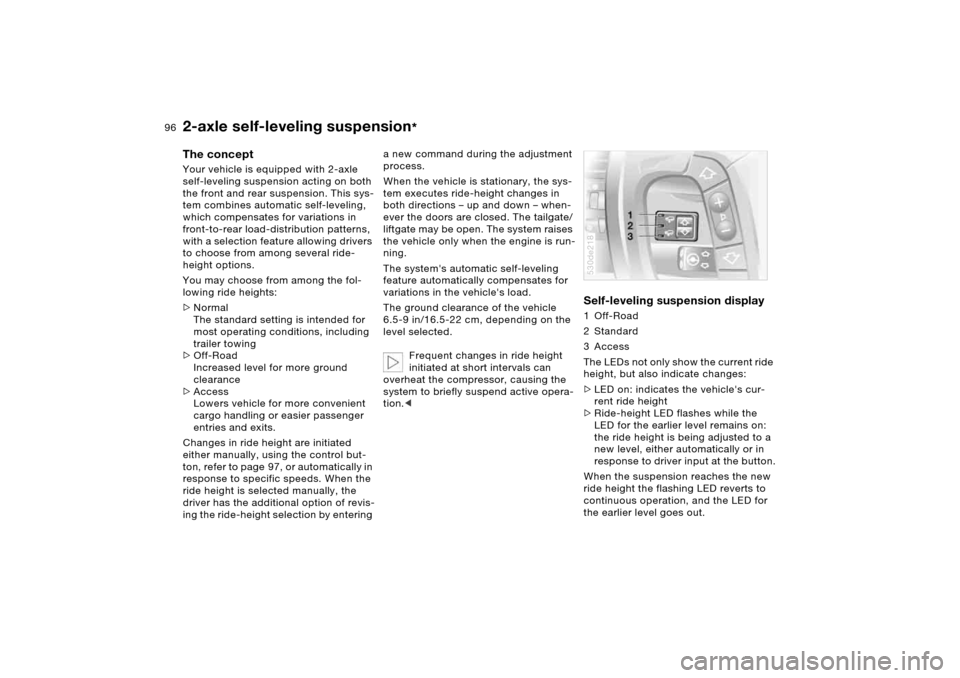
96n
2-axle self-leveling suspension
*
The concept Your vehicle is equipped with 2-axle
self-leveling suspension acting on both
the front and rear suspension. This sys-
tem combines automatic self-leveling,
which compensates for variations in
front-to-rear load-distribution patterns,
with a selection feature allowing drivers
to choose from among several ride-
height options.
You may choose from among the fol-
lowing ride heights:
>Normal
The standard setting is intended for
most operating conditions, including
trailer towing
>Off-Road
Increased level for more ground
clearance
>Access
Lowers vehicle for more convenient
cargo handling or easier passenger
entries and exits.
Changes in ride height are initiated
either manually, using the control but-
ton, refer to page 97, or automatically in
response to specific speeds. When the
ride height is selected manually, the
driver has the additional option of revis-
ing the ride-height selection by entering a new command during the adjustment
process.
When the vehicle is stationary, the sys-
tem executes ride-height changes in
both directions – up and down – when-
ever the doors are closed. The tailgate/
liftgate may be open. The system raises
the vehicle only when the engine is run-
ning.
The system's automatic self-leveling
feature automatically compensates for
variations in the vehicle's load.
The ground clearance of the vehicle
6.5-9 in/16.5-22 cm, depending on the
level selected.
Frequent changes in ride height
initiated at short intervals can
overheat the compressor, causing the
system to briefly suspend active opera-
tion.<
Self-leveling suspension display 1 Off-Road
2Standard
3 Access
The LEDs not only show the current ride
height, but also indicate changes:
>LED on: indicates the vehicle's cur-
rent ride height
>Ride-height LED flashes while the
LED for the earlier level remains on:
the ride height is being adjusted to a
new level, either automatically or in
response to driver input at the button.
When the suspension reaches the new
ride height the flashing LED reverts to
continuous operation, and the LED for
the earlier level goes out.530de218
Page 100 of 202

100n
Parking lamps/side marker lamps
The front, rear and side vehicle
lighting is switched on. You can
use the parking lamps for park-
ing. For lighting on one side for parking
as an additional feature, refer to
page101.
Low beams
When the ignition is switched off
and the low beams are on, only
the parking lamps/side marker
lamps remain on.
530us215
Pathway lighting:
When you activate the headlamp
flasher after parking the vehicle and
switching off the lamps, the low beams
will come on for a brief period. You may
also have this function deactivated if
you wish.<
Lights on warning Whenever you open the driver's door,
after having turned the ignition key to
position 0, an acoustic signal will sound
for a few seconds to remind you that
the lamps have not been switched off.
Alphanumeric Check Control
*:
The reminder is given through the
Check Control.
Daytime driving lamps
*
The headlamps are automatically
switched on for daytime driving at igni-
tion key position 2.
Automatic headlamp control
*
When you set the switch to this
position, the system activates
and switches on and off the low
beams in response to changes in ambi-
ent light conditions, for instance, in tun-
nels, at dawn and dusk, and in rain and
snow.
The low beams remain switched
on regardless of the ambient light
when you switch on the front fog
lamps.<
Automatic headlamp control can-
not serve as a substitute for the
driver's judgment in determining when
the vehicle lamps should be switched
on. For example, the system cannot
detect fog. To avoid safety risks, you
should always switch on the lamps
manually under these conditions.<
You can have the sensitivity of the
headlamp control system adjusted
on your vehicle.<
Parking lamps/low beams
Page 103 of 202
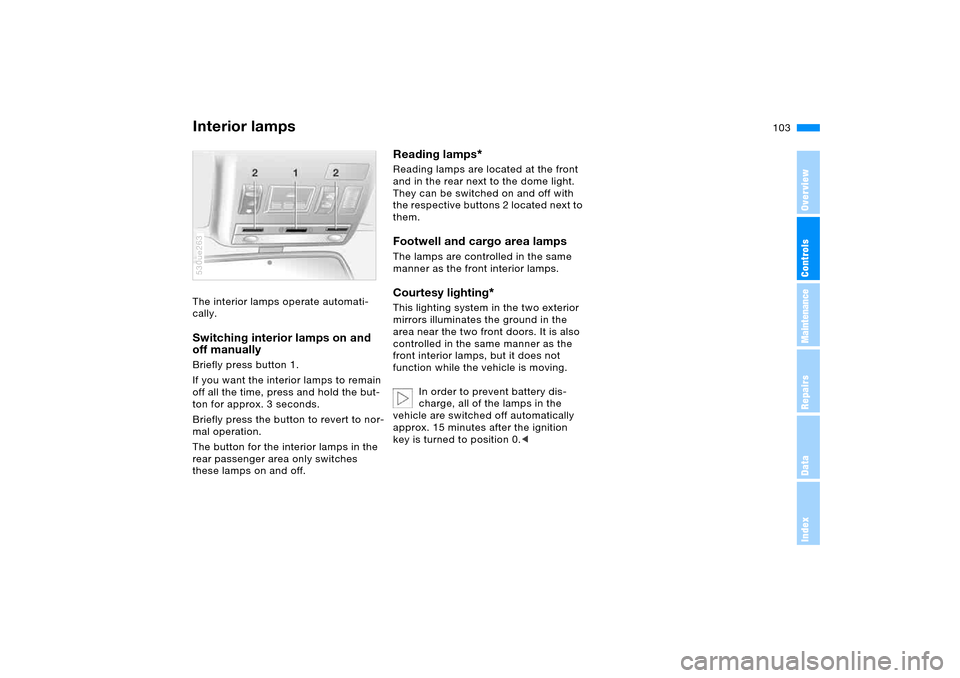
103n
OverviewControlsMaintenanceRepairsDataIndex
Interior lamps The interior lamps operate automati-
cally. Switching interior lamps on and
off manually Briefly press button 1.
If you want the interior lamps to remain
off all the time, press and hold the but-
ton for approx. 3 seconds.
Briefly press the button to revert to nor-
mal operation.
The button for the interior lamps in the
rear passenger area only switches
these lamps on and off. 530ue263
Reading lamps
*
Reading lamps are located at the front
and in the rear next to the dome light.
They can be switched on and off with
the respective buttons 2 located next to
them.Footwell and cargo area lamps The lamps are controlled in the same
manner as the front interior lamps.Courtesy lighting
*
This lighting system in the two exterior
mirrors illuminates the ground in the
area near the two front doors. It is also
controlled in the same manner as the
front interior lamps, but it does not
function while the vehicle is moving.
In order to prevent battery dis-
charge, all of the lamps in the
vehicle are switched off automatically
approx. 15 minutes after the ignition
key is turned to position 0.<
Page 105 of 202

105n
OverviewControlsMaintenanceRepairsDataIndex
Air conditioner Temperature
The graduations on the dial
provide general reference val-
ues for the interior tempera-
ture. 707/226 is recom-
mended as a comfortable setting. After
driving begins, the selected tempera-
ture is reached as quickly as possible
and kept constant by the control sys-
tem.
Air distribution
You can direct air to flow onto
the windows , toward the
upper body and into the
footwell . All intermediate
settings are possible. In the setting,
there is a low flow of air onto the win-
dows to keep them free of condensa-
tion.
Air supply
You can adjust the air supply
through an infinitely-variable
range. The heating and venti-
lation become more and more
effective as the air supply settings are
increased. In the 0 setting, the blower
and climate control are switched off
and the outside air supply is blocked.
Rear window defroster
When the rear window
defroster is activated, the
LED lights up. The rear window
defroster switches off automatically.
Air conditioning
The air is cooled and dehu-
midified and — depending on
the temperature setting — warmed
again. Depending on the weather, the
windshield may fog over briefly when
the engine is started. You can reduce
condensation forming on the windows
by switching on the air conditioning.
During air conditioning, condensa-
tion forms, which then exits under
the vehicle. Traces of water on the
ground are therefore normal.<
Recirculated-air mode
You can respond to unpleas-
ant odors outside the vehicle
by temporarily switching off the outside
air supply. The system then recirculates
the air currently within the vehicle.
You can also use the button on the
steering wheel to switch over to the
recirculated-air mode, refer to page 23.
If the windows fog over in the
recirculated-air mode, switch the
recirculated-air mode off and increase
the air supply as required.<